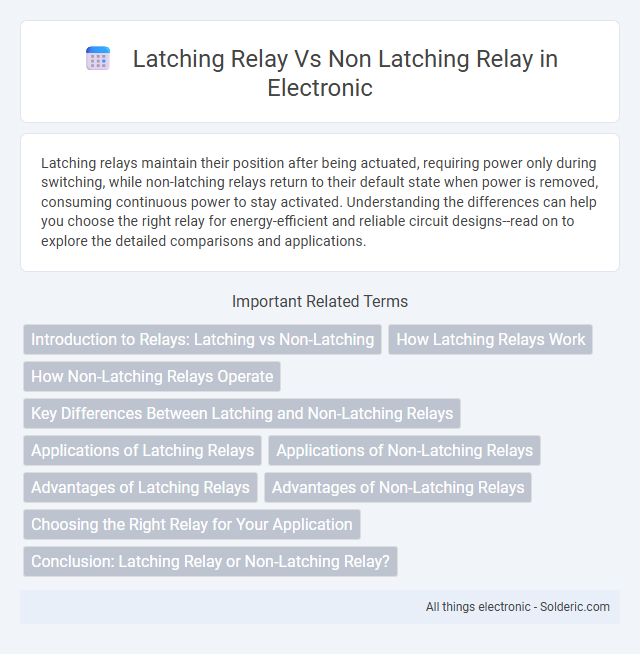Latching relays maintain their position after being actuated, requiring power only during switching, while non-latching relays return to their default state when power is removed, consuming continuous power to stay activated. Understanding the differences can help you choose the right relay for energy-efficient and reliable circuit designs--read on to explore the detailed comparisons and applications.
Comparison Table
| Feature | Latching Relay | Non-Latching Relay |
|---|---|---|
| Operation | Maintains position after coil is de-energized | Returns to default position when coil is de-energized |
| Power Consumption | Power needed only during switching | Continuous power required to maintain state |
| Applications | Energy-saving switches, memory circuits | General switching, automotive, industrial controls |
| Complexity | More complex mechanism with bi-stable state | Simpler, single stable state mechanism |
| Cost | Generally higher due to complexity | Lower cost, widely used |
| Switching Time | Comparable to non-latching relays | Fast switching suitable for frequent use |
| Control Coil | Typically requires two coils or polarity reversal | Single coil operation |
Introduction to Relays: Latching vs Non-Latching
Latching relays maintain their contact position after the control signal is removed, reducing power consumption and ensuring state retention during power loss. Non-latching relays revert to their default state when control power is interrupted, requiring continuous energy to maintain the active position. The choice depends on application requirements like energy efficiency, fail-safe operation, and control complexity.
How Latching Relays Work
Latching relays operate by maintaining their position without continuous power, using a magnetic latch to hold the contacts in either the open or closed state. When energized briefly, the relay switches states and remains latched due to permanent magnets or a mechanical catch until a reset pulse is applied. Your circuits benefit from reduced power consumption and reliable memory retention in case of power loss with latching relays.
How Non-Latching Relays Operate
Non-latching relays operate by using an electromagnetic coil that, when energized, creates a magnetic field to move the switch contacts, closing or opening the circuit temporarily. Once the coil de-energizes, a spring mechanism returns the relay to its default position, making it ideal for applications requiring momentary switching. Your control system benefits from non-latching relays when precise, temporary activation is necessary without maintaining power to keep the state.
Key Differences Between Latching and Non-Latching Relays
Latching relays maintain their position after the actuating current is removed, using a magnetic or mechanical latch, which reduces power consumption and is ideal for memory circuits. Non-latching relays require continuous power to hold their state, making them suitable for applications needing rapid switching and fail-safe operation when power is lost. The key differences include power usage, state retention without power, and application suitability in control systems.
Applications of Latching Relays
Latching relays are ideal for applications requiring energy-efficient switching and memory retention, such as smart metering, home automation, and automotive systems. They maintain their state without continuous power, making them suitable for battery-operated devices and reduce power consumption significantly. Your choice of a latching relay enhances system reliability in power-sensitive environments and remote control applications.
Applications of Non-Latching Relays
Non-latching relays are commonly used in applications requiring momentary activation, such as controlling lighting circuits, motor starters, and alarm systems. Their ability to return to the default state when power is removed makes them suitable for safety devices and time-sensitive operations. Your choice of a non-latching relay ensures reliable, temporary switching without the need for manual reset.
Advantages of Latching Relays
Latching relays offer significant energy efficiency by maintaining their position without continuous power, reducing power consumption in your electrical systems. They provide enhanced reliability in applications where power interruptions occur, as they retain their last state without the need for constant coil excitation. These relays are ideal for battery-powered devices, smart meters, and remote control applications due to their stable memory function and lower heat generation.
Advantages of Non-Latching Relays
Non-latching relays offer continuous power supply to coils for maintaining contacts, ensuring stable and immediate switching without external mechanisms. They provide simpler control circuitry and faster response times, making them ideal for applications requiring rapid state changes and fail-safe operation. Their inherent design minimizes bounce effect and enhances reliability in automation and control systems.
Choosing the Right Relay for Your Application
Latching relays maintain their position after the actuating coil is energized, requiring power only during switching, which makes them ideal for energy-efficient applications and memory retention in circuits. Non-latching relays return to their default position once power is removed, offering simplicity and reliability for applications needing constant power during operation. Selecting the right relay depends on factors such as power consumption, application duration, and whether the circuit requires a maintained state without continuous power.
Conclusion: Latching Relay or Non-Latching Relay?
Latching relays maintain their position without continuous power, offering energy efficiency and reliability in memory-retentive applications. Non-latching relays require constant power to stay activated, making them suitable for simple, short-duration switching tasks. Your choice depends on whether you prioritize power saving and state retention (latching) or straightforward operation with continuous power (non-latching).
latching relay vs non latching relay Infographic

 solderic.com
solderic.com